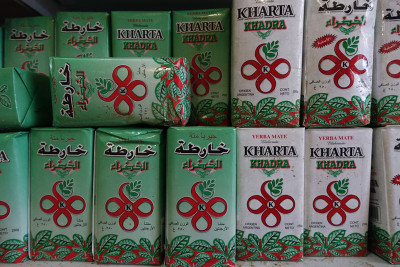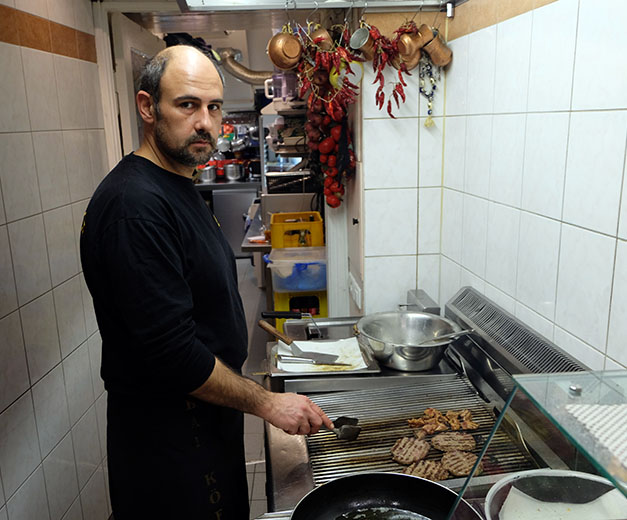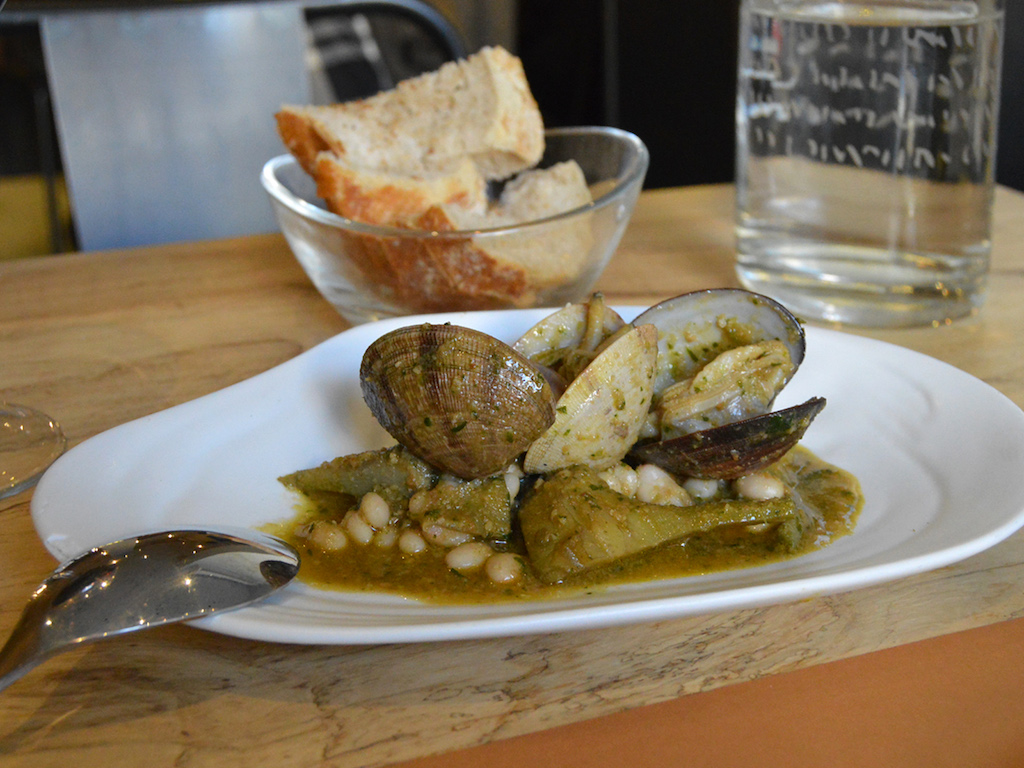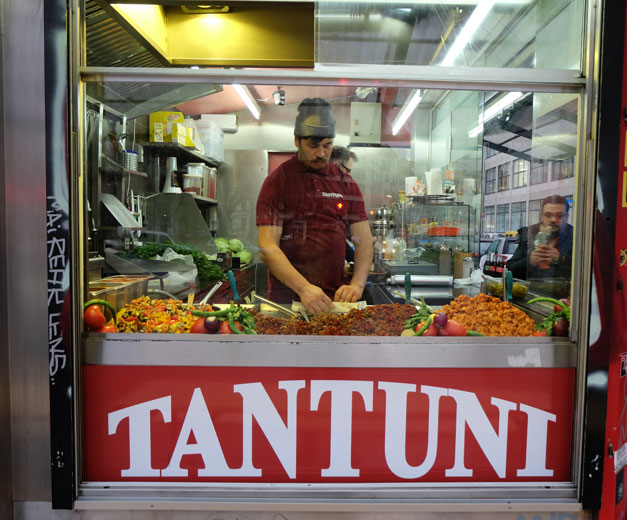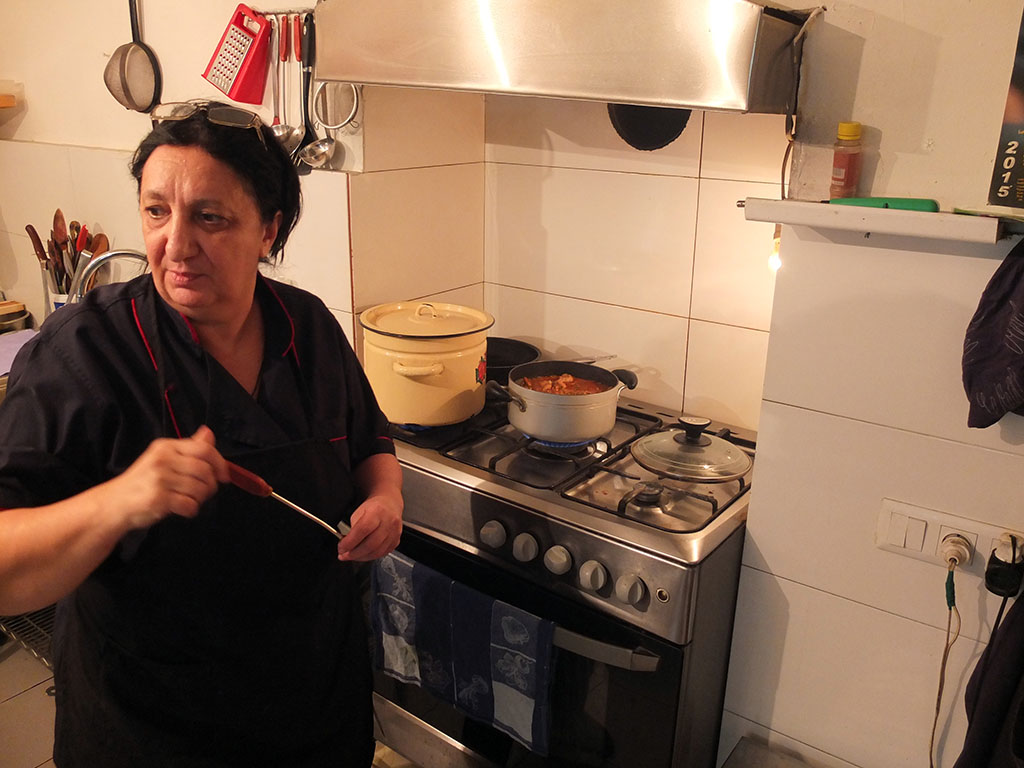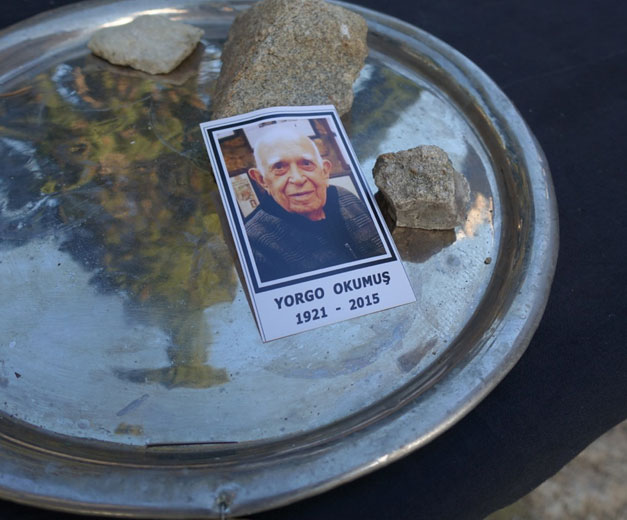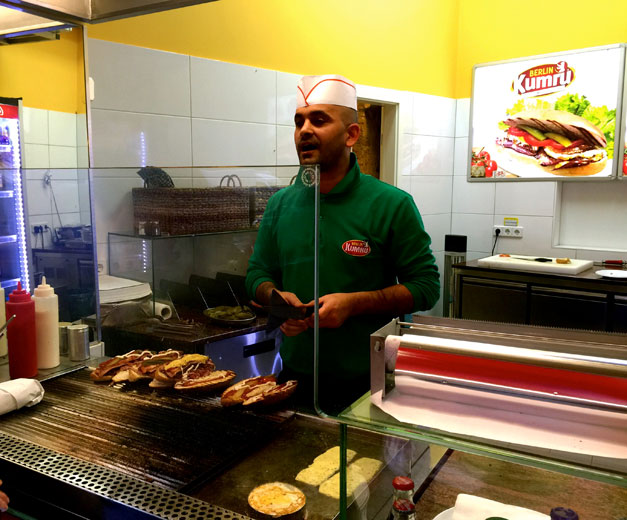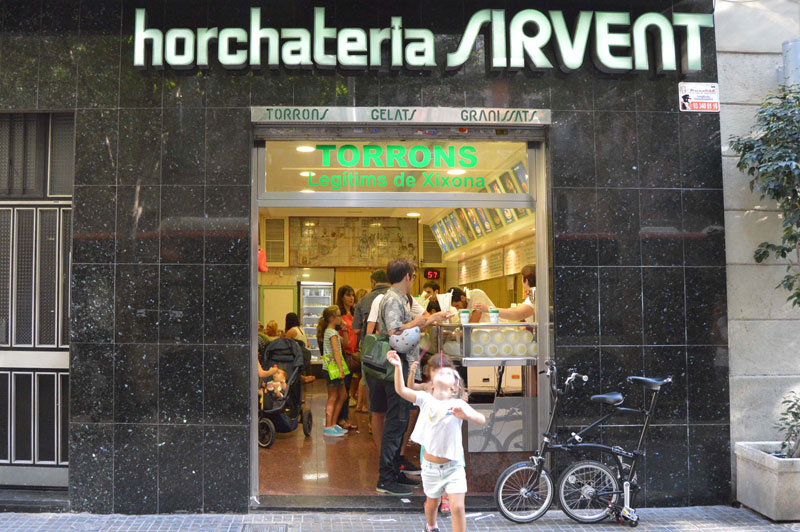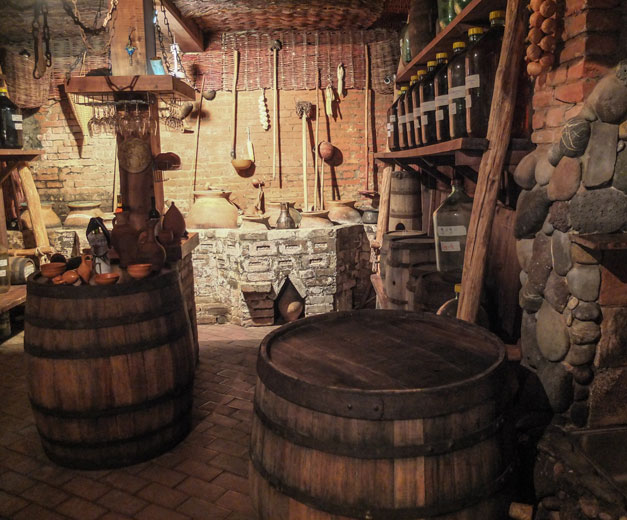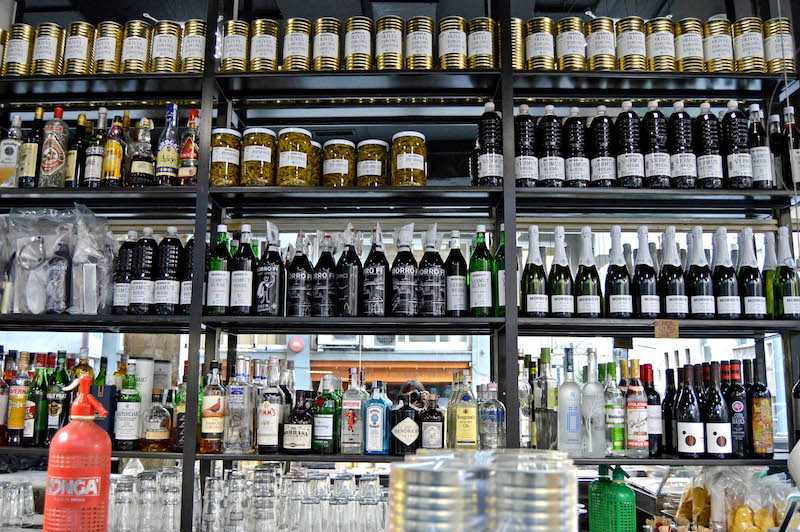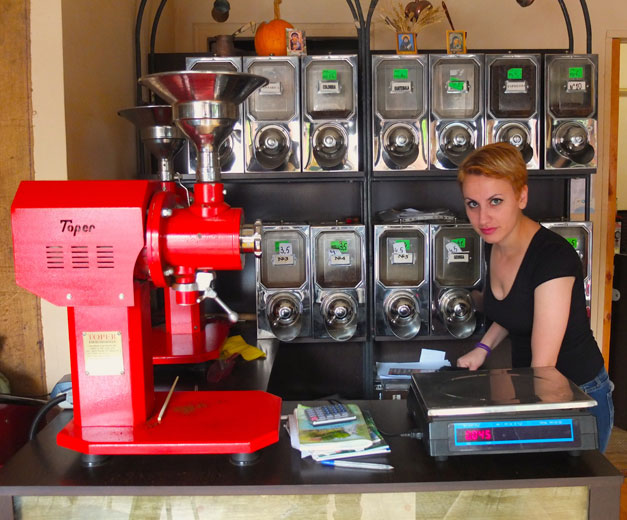We can't find the internet
Attempting to reconnect
Something went wrong!
Hang in there while we get back on track
Search results for word=paul+r
Istanbul
Simitçi Feridun: May the Simit Be Unbroken
The sound of bombs has become an all too frequent occurrence in Istanbul as of late, and residents of the city's Cihangir neighborhood were spooked as ever when an explosion occurred in a building overlooking the main square early on a recent Sunday morning. Blasts sound no less scary when they are the result of gas leaks. When the smoke cleared, 75-year-old Feridun Yükseltürk was found crushed under the fallen rubble, just steps from the spot where he sold simit from a cart daily for the past six years. The tragedy sent shockwaves through Cihangir, where Feridun was a beloved figure renowned for his unwavering generosity.
Read moreIstanbul
Behind Bars: Terminal Nostalgia at Mythos
In Istanbul's iconic Haydarpaşa train terminal, the door of a crowded restaurant and bar opens to beams of sparkling light streaming across the Marmara Sea coast. Trains haven't departed Haydarpaşa for nearly three years while the station undergoes extensive renovations, but its restaurant, Mythos, is still open and popular as ever, a refuge for a faithful crowd of regulars, who come to drink at a train station even though they aren’t going anywhere. Built in the first decade of the 20th century by the Germans and gifted to Sultan Abdülhamid II, the station is a handsome and prominent icon of the city, an imposing presence on the city's Anatolian shoreline.
Read moreTbilisi
Behind Bars: For Love of God and Chacha at Wine of Kardenakhi
It is 9 p.m. and we are packing our bags for a red-eye flight to Poland when I realize we have no chacha, Georgia’s otherworldly elixir of distilled fermented grape pulp. We never, ever travel without chacha, and there is no way we’re going to buy over-the-counter, factory-produced product – and not because it’s over-priced. Chacha is a potion brewed by the hands of masters over wood fires in hammer-battered stills sealed in a paste of dirt and ash. Without the human touch – the artistry – chacha is just a soulless, liver-grinding liquor. I make the call. Andria deals in wine, chacha and religion from a devilish little cellar in Tbilisi’s old neighborhood of Sololaki.
Read moreIstanbul
Around Kumkapı – and the World – in a Day
In Istanbul, there is a single neighborhood where one can find Uzbek mantı, imported Ethiopian spices and hair products, smuggled Armenian brandy, Syrian schwarma and sizzling kebap grilled up by an usta hailing from southeast Turkey’s Diyarbakır. Kumkapı – a shabby seaside strip of century-old homes, Greek and Armenian churches and residents from a vast array of countries that most Americans couldn't pick out on a map – is far and away the most diverse place in Istanbul. Nowhere else comes close. In perpetual motion, Kumkapı is home to a rotating cast of eclectic restaurants that cannot be found anywhere else in the city. Many of these open and close before we can squeeze in a second visit.
Read moreRio
Quetzal: When Life Gives You Cacao Beans
As an electrician in the Galeão international airport, Emerson Gama responded to emergencies like exploding transformers. But in his spare time, he was becoming a self-made expert on Latin American mythology, tropical ecology and sustainable resource management. These passions led him to quit his job four years ago; since then, Gama has become the Rio de Janeiro chocolatier with the most dedicated cult following. Only a few South Zone specialty stores carry his Quetzal chocolates, and where they come from is largely unknown, both to the clients on the long waiting lists for deliveries and to Gama’s own neighbors. The “secret” source?
Read moreIstanbul
Let Them Eat Lettuce: Reviving an Endangered Urban Green
When you think about lettuce, if you think about it at all, it’s probably as the bland but virtuous base to a salad. But in days past in Turkey, this leafy green was just as often consumed as a snack in itself, as an essential part of a main dish or even as a sweet treat. “Marul [romaine] has been cooked as a vegetable since ancient Greek, Roman, and Byzantine times,” says food writer Aylın Öney Tan. “In many parts of Anatolia, it was a spring tradition to dip marul in pekmez (molasses) or honey, to eat it with something sweet that contrasted with the lettuce’s bitterness.” This wouldn’t really work with supermarket iceberg, of course – to fully enjoy lettuce’s culinary potential requires a fresh, high-quality crop.
Read moreRio
Bar do Momo: Soul Pub
At Bar do Momo in Tijuca, there are many things to celebrate, but the two dishes starring jiló are particularly magnificent – and show how this little gastropub punches well above its weight. A green, meaty, slightly bitter cross between an eggplant and a pepper, jiló was brought to Brazil from West Africa during the slave trade. At Bar do Momo, the vegetable is served two ways: One is the jiló recheado, not unlike a chile relleno, stuffed with beef and mozzarella cheese that melts into a savory broth. The other is the only Brazilian guacamole worth your time: made from tangy pickled jiló, red onion, tomato, lime, cilantro, and Brazilian dedo de moça pepper.
Read moreBuenos Aires
CB on the Road: On the Yerba Mate Trail
To call the drinking of yerba mate a fixation in parts of South America would be an understatement. Yerba mate (MAH-tey) in Argentina and Uruguay is consumed regularly by an estimated 98 percent of the population, and, like tea in other countries, has social and cultural significance and rituals associated with friendship, business relationships, leisure, hospitality, etiquette and national identity. As a social ritual, mate brewing requires a bit more than just yerba, the vessel (calabaza), straw (bombilla) and hot water (80 degrees C – 175 degrees F – is the usual temperature, but around 50 degrees C or 120 degrees F is preferred); if you are in a group setting, you’ll also need to know a bit of its language of respect and solidarity.
Read moreIstanbul
Feriköylu Ömer Usta: Köfte Club
The triangle of Kurtuluş, Feriköy and Bomonti represents an Istanbul on the verge of fading away. Though still inhabited by significant numbers of Greeks, Jews and Armenians, there are more local churches and synagogues than are used by the remnants of those diminished communities. The numerous schools, houses of worship and cemeteries are relics testifying to the cosmopolitanism that once defined this segment of inner Istanbul. Another nostalgic quality of the area is its small-business culture, still thriving, yet on the verge of a major shift.
Read moreTbilisi
Rhea's Squirrels Café Gallery: Cheese Pie, With a Mission
The kids were playing in the park, and Dad needed a cup of coffee for the caffeine boost to keep up with his daughter. Luckily there was a café nearby – where you would least expect one. The park is a modest little playground patch in a residential neighborhood across from the funicular that hauls people up and down Mtatsminda mountain to the amusement park and restaurant above the city. The café is on the ground floor of a Communist-era apartment block, just a couple dozen paces away. It was everything a little coffeehouse should be: warm, cozy, quiet and wheelchair accessible.
Read moreIstanbul
Horhor Dürüm Evi: Family (Kebab) Values
We could devote a weekly column to the culinary treasures of Istanbul’s polyglot Aksaray district and probably never have to worry about running out of things to say. The area is jam-packed with places to eat, and while we've written about many of them, Aksaray just keeps on delivering. Having previously covered the Syrian, Georgian, Azerbaijani and Uighur restaurants that make Aksaray a true patchwork of culinary destinations, our most vulnerable soft spot still lies in the strip of kebab restaurants inspired by the cuisine of southern Turkey’s Hatay and Urfa and located adjacent to the metro station.
Read moreTbilisi
Sasadilo Coca-Cola: The Real Thing
There used to be a state-owned publishing house in our neighborhood with a cafeteria that served a proletariat menu that included ostri (beef stew), cold slices of beef tongue and cutlets with buckwheat or mashed potatoes. It was a stolovaya, which is the Russian word for “canteen,” but a more accurate translation would be “human fueling station of protein, carbs and vodka.” It was gutted several years ago; its ghosts now haunt the dining room of a designer hotel.
Read moreTbilisi
The Khinkali Chronicles, Part II: Zakhar Zakharich
In Tbilisi, we have mornings when we wake up wrinkled and dehydrated, and as we lie in bed knuckling the sleep from our eyes, we hear an all too familiar chorus beckoning us to “bite me, slurp me, gobble me down….” That is khinkali singing, and when you hear the melody, your day has been cast. You can forget about work and responsibilities. We used to fritter away our afternoons with a platter of khinkali at Pasanauri, but when it changed owners and attitude and our beloved waitress Irma packed her bags, it was clear an era had passed. A period of pretty good khinkali at pretty good restaurants followed until we asked local filmmaker and fellow gastromaniac Levan Kitia where he goes for khinkali.
Read moreIstanbul
Yılmaz Tandır Evi: Little Erzincan
Wave after wave of migration from Anatolia has bestowed upon Istanbul a population of 15 million at bare minimum, with countless pockets of the city representing villages and districts from every last corner of the country. In the neighborhood of Feriköy, those originally hailing from the eastern province of Erzincan have managed to consolidate their presence on an entire street. Lined with a number of restaurants and shops selling fresh goods typical of the province, and a row of village associations established for the purpose of maintaining cultural ties between those living in Istanbul and their relatives back home, Feriköy's Gediz Sokak is all about Erzincan, a land of sheep and mountains famed for its dairy products.
Read moreBarcelona
Closing Time: The End of an Era in Barcelona
After four generations of doing business in the same shop – housed since 1907 in a beautiful moderniste building between Paseo de Gràcia and Gran de Gràcia – the beloved patisserie La Colmena has closed. One of Barcelona’s most iconic and historic establishments, La Colmena made some of the best artisanal candies, turrón de Jijona, Lenten fritters and Swiss rolls (called a brazo de gitano, or “Gypsy arm” in Spanish) in the neighborhood, and was run by siblings Cristina and Francesc Font, the fifth generation of the family. The venue was effectively forced to close because its rent was set to more than triple, and because of a requirement by City Hall that they restore and update the premises. Although Barcelona residents were aware of the situation, the owners’ decision to close still came as something of a shock to longtime customers.
Read moreLisbon
Chafariz do Vinho: The Fountain of Wine
Beneath modern Lisbon lies a complex network of galleries belonging to the city’s 18th-century aqueduct, a monumental structure that resisted the 1755 earthquake that devastated much of the capital. The aqueduct’s 58 km of tunnels and underground channels distributed water to 33 chafarizes (fountains) – often ornamental – to supply the city with drinking water. One of them, located along the steep steps connecting the Avenida and Príncipe Real neighborhoods, now houses Chafariz do Vinho, the Portuguese capital’s oldest enoteca, or wine bar.
Read moreIstanbul
Damla Dondurma-Boza: Micro Brew
We’re not quite sure what we like about boza, a drink made from slightly fermented millet that is popular in Istanbul during the wintertime. The thick beverage tastes like a combination of applesauce and beer-flavored baby food, though we warmly recall the strength it gave us one blustery December day. On that relentlessly rainy morning as we crossed the Bosphorus aboard the ferry from Kadıköy to Eminönü, just one small bottle of boza gave us a sharp kick in the britches, making us feel the way we imagine Popeye does after wolfing down a can of spinach.
Read moreBarcelona
Barcelona's Artisanal Candy: How Sweet It Is
Barcelona is paradise for those with a sweet tooth. Pastries, nougats, cakes, chocolates and candies can be found in every neighborhood, all year long. We’ve written previously about turrón, artisanal gelats, chocolate and seasonal specialties such as panellets, tortells and buñuelos, but beyond of all these (and others), there are the city’s beloved hard candies. Let’s start with the eminence grise. The patisserie La Colmena (“The Hive”) has two locations, the first of which opened in 1835 on Gran de Gràcia, the second in 1849 on Plaça de Àngel. For a time, the shops were run by different branches of the same family, and eventually each went its separate way. Both shops continue to make Spain’s oldest artisanal candies, square-shaped sweets flavored with honey or Mediterranean flavors like thyme, rosemary and citrus. The original candy was made with single-varietal honey from rosemary flowers and sugar and was hugely popular in both shops’ neighborhoods. As might be expected, the two businesses share more than just genetics: All the candies in both shops are made by hand, with natural essences and without any kind of artificial flavors or preservatives. There are a few differences between the two Colmenas too.
Read moreTbilisi
Citron Plus: From Stage to Table
Tbilisi’s Vake Park district is an upscale neighborhood full of designer cafés and fancy-looking Georgian-European restaurants offering mediocre grub at prices that complement the black SUVs and silver Mercedes that crowd the streets. Sure, you can find a good place that serves up the typical tasty Georgian menu at a fair price. But for original Georgian cooking with particular attention to fresh ingredients and the process of putting them together so that all the individual flavors explode in your mouth, look no further than Citron Plus.
Read moreIstanbul
Korkmaz Büfe: Poetry in Rotation
Istanbul’s Kadıköy district on the city’s Asian side has long been billed as a calmer, more laid-back alternative to some of its swarming, chaotic European counterparts, and it seems everyone’s figured that out by now. Though the rocks that straddle a long stretch of winding, serene shoreline still make for one of the most relaxing hangout places in the city, the pedestrian Mühürdar Caddesi running through the heart of Kadıköy is choked with foot traffic on the weekends, while a staggering number of bars and coffee shops have appeared on the scene within the past two to three years.
Read moreBarcelona
Can Pineda: A Workers' Canteen Grows Up
The rustic family favorite Can Pineda has been holding down this corner of Barcelona’s El Clot neighborhood since 1904. It was not a restaurant originally, but a typical wine shop and canteen, where plenty of life could be found amongst the wooden barrels that now slumber peacefully on their perch up above the dining room. At that time, the place was frequented by local factory workers, who would come for a glass of wine to go with a simple meal or to drink while warming up their lunch boxes. The then-owners would put a pine branch on the door to signal the arrival of the vi novell, or new wine of the year, and from the pine, pi in Catalan, came the name Can Pineda, which translates roughly to “The Pine House.” Today, El Clot is part of the new high-tech 22@ district, which is focused on innovation and research but maintains in its oldest streets the spirit of the village (Sant Martí de Provençals) that once flourished here, with its own market (dating back to 1889) and walls that remain from Barcelona’s first Industrial Age. Can Pineda sits right in the middle, a small but welcoming eatery with just 30 seats, decorated with the characteristic blue azulejos tiles, those wooden barrels and a few excellent hams hanging behind the bar.
Read moreElsewhere
Bal Köfteci: Sweetish Meatballs
It might sounds sacrilegious, but when we’re in Berlin, döner isn’t our go-to street sandwich. Though it is widely believed that the German capital is the birthplace of the beloved sandwich, that fact alone does not provide citywide quality assurance. The rapid ascension of the döner sandwich as the city’s eminent fast-food staple has unfortunately resulted in its mass production, which means one is likely to encounter a nondescript rotating wheel of frozen mystery meat. This isn’t to say that excellent yaprak döner (a carefully crafted cylinder consisting of freshly layered cuts) cannot be found in Berlin. But the way the sandwich is dressed in this city – with a variety of vegetables, sauces, cheese and fresh-squeezed lemon or lime – is indeed conducive to covering up the taste of boring meat.
Read moreBarcelona
Best Bites 2015: Barcelona
Editor’s note: We’re celebrating another year of excellent backstreets eating by taking a look back at our favorite restaurants and dishes of 2015. La Panxa del Bisbe Xavi Codina has created a menu of almost 30 tapas or platillos (small dishes) and four desserts, combining traditional Catalan cuisine with international influences that Codina has encountered in his life or in the neighborhood. Much of the menu changes according to season and customers’ tastes, but there are a few perennial favorites, such as the homey croquettes, with their generous quantity of chicken and carrots; duck liver with pears and wine; and the cap i pota, a traditional dish made from pork trotters and head, which the chef tweaks throughout the year.
Read moreTbilisi
Best Bites 2015: Tbilisi
Editor’s note: Tbilisi was a new addition to Culinary Backstreets this year, and as we look back on all the great eating we did in 2015, we can’t help but notice that so much of it took place in the city's Sololaki area. There’s a typecast in Georgia that when somebody wants to go into business, they open up a khinkali restaurant. There is a logic to that. About a million people live in Tbilisi, a city built impetuously along the hilly banks of the Mtkvari River. And the adoration every single one of these people has for this boiled dumpling is so reverent, it is as if they see Jesus and his disciples feasting on a steaming platter of kalakuri khinkali for the Last Supper as they bite a hole into the dumpling and slurp its tasty broth.
Read moreIstanbul
Best Bites 2015: Istanbul
Editor’s note: To give 2015 a proper send-off, we’re taking a look back at all our favorite eating experiences this year. Hamo’nun Yeri The nohut dürüm, a simple wrap of mashed chickpeas, peppers, parsley and spices, may be a popular breakfast choice in certain districts of the southeastern province of Gaziantep, but we'll eat it anytime and are prepared to travel far and wide to do so, as this treat is by no means common in Istanbul. Hamo'nun Yeri is located in Güngören, a densely packed working-class district located well outside the radar of tourists and more affluent Istanbulites. Made with bread hot out of the oven from the family's bakery down the block, the dürüm – and a chat with the friendly Gül brothers – is more than worth the trip. Address: Güngören Merkez Mah., İkbal Sokak 9/B, Köyiçi Telephone: +90 535 016 0316 Hours: 7am-10pm —Paul Osterlund
Read moreElsewhere
Toros: Tantuni (the Kreuzberg Remix)
In Berlin, there is no shortage of meatless options, and vegetarians can even rejoice in a seitan-based döner kebab that is given the proper spit roast. What did surprise us is that the ubiquity of vegetarian diets in the city has greatly impacted one version of a meat-centric Turkish street food classic. Toros Tantuni is a small stand that occupies a rather lonely corner of the central part of the Kreuzberg district, a place once inhabited by a ragtag mix of immigrants, squatters and activists, ignored by most Berliners who could afford to live elsewhere. In recent years, however, the area has been thoroughly spritzed with the essence of gentrification and has a flood of innumerable bars, coffee shops and boutiques.
Read moreTbilisi
Shavi Lomi: The Black Lion for Golden Guests
In the Caucasus, guests are considered gifts from God. Georgians like to call them okros stumrebi – “golden guests” – an endearment that illustrates the stature the ever-hospitable Georgians give to those they host. And whenever our own golden guests come to visit in this remote corner of the world, we never fail to entertain them in our own surrogate dining room, Shavi Lomi (the Black Lion).
Read moreIstanbul
Farewell, Yorgo: The "Heart of Beyoğlu" Passes On
On any given night, bustling, narrow Nevizade Street in the heart of Istanbul’s Beyoğlu district buzzes with thick crowds of evening revelers searching for the best table while clean-shaven waiters in their customary uniform of pressed white shirts and V-neck sweaters attempt to lure the crowds into their establishments.
Read moreElsewhere
Berlin Kumru: Ich Bin Ein İzmirli
The kumru sandwich – a specialty of Turkey's Aegean coastal resort district Çeşme – is one of our top guilty pleasures. It comes as heavy on the guilt as it does on the pleasure, with its sodium-laden, coma-inducing blend of grilled hot dog strips, salami slices and buttons of garlicky sucuk topped with melted kaşar cheese, fresh tomatoes and pickles served on a grill-toasted roll somewhat resembling a turtledove (kumru in Turkish).
Read moreIstanbul
Dürümcü Mehmet’in Yeri: The Sharing Economy
Istanbul’s Aksaray neighborhood harbors an unfortunate reputation derived from its seedy nightclubs and the heavy presence of illegal brothels, which turn profits from sex trafficking. But as the city continues to transform at dizzying speeds, Aksaray’s status as an underbelly has begun to be overshadowed by that of a diverse, exciting culinary destination. Streetside Syrian cafés churning out cheap and reliable falafel and shawarma; a handful of Uighur restaurants serving dishes of spicy peppers and succulent morsels of beef bathing in handmade noodles prepared to order; and Georgian drinking dens, where chacha, a grape-based moonshine, is brought out in plastic water bottles alongside juicy, lovingly made dumplings, are just a few of the international cuisines that can be sampled in Aksaray.
Read moreTbilisi
Ezo: Just Like Mom's
The 19th-century homes in old Tbilisi neighborhoods were built in a style Georgians call “Italian Courtyards,” where through a gate or arch you enter a quad enclosed by stories of balconies shared by each family on the floor. This courtyard was the nucleus of each building, where kids safely romped around, monitored by adults from the windows above, as men contemplated domino moves at a table under a tree and women beat rugs on an iron rack in a corner.
Read moreRio
Food Complex: A Favela's Culinary Side Emerges
Comprising a city within a city made of housing complexes and self-built neighborhoods, the Maré favela complex in Rio’s North Zone packs 130,000-plus residents into the area between the Avenida Brasil highway and Guanabara Bay, just south of Rio’s International Airport.
Read moreBarcelona
Building Blocks: Spain's Big Little Fish
Editor's note: To inaugurate our new series, Building Blocks, which explores the fundamental ingredients of the cuisines we cover, we turn to Spain, where anchovies play a large role in the cooking of many regions there. Anchoa, boquerón and bocarte: These names – in Spanish, Basque and Catalan, respectively – all describe the same little fish, the anchovy, and to make matters more confusing, the names also indicate how the fish is prepared, depending on what region you’re in.
Read moreIstanbul
Meşhur Öz Suruç: The Yellow and the Green
To the uninitiated, the restaurant owners of a small corner of Istanbul’s Yenibosna neighborhood might come off as having an unhealthy obsession with particularly garish versions of the colors yellow and green. As we recently explored the lower end of the Yenibosna neighborhood, one of Istanbul’s large periphery boroughs, we stumbled upon a small cluster of kebap shops spread out amid a run-down yet bustling strip of auto repair shops and congested rows of apartments, with each eatery’s sign decked out in identical yellow and green trim.
Read moreIstanbul
Bus Fare: A Transit Terminal's Food to Go
The Yenibosna bus station sits at the intersection of numerous transit routes, where passengers can embark on journeys to the furthest corners of the city as well as to its beating heart. Close to Istanbul’s main airport, and wedged in beneath several high-rise towers that seem to have ascended from the ground overnight, the bus station sits adjacent to a major metro line and below the main E-5 highway, with the grubby, crowded neighborhood of Yenibosna to the north.
Read moreBarcelona
Norte: Northern Exposure
On a beautiful corner of L’Eixample sits Norte, a small yet warm, inviting and light-filled bar with a constellation of shining lights spelling out its name inside and a few tables with fresh flowers. The restaurant was started by three partners, Lara Zaballa, María González and Fernando Martínez-Conde (who left the project last year). They met while working at Barcelona’s acclaimed Moo restaurant and had come to cooking from studying philosophy, art history and journalism at university. They were each looking for something more hands-on, work that gave them direct physical contact with matter, and that shared motivation connected them from the beginning. All three also came to Barcelona from other cities in northern Spain. After their experience at Moo and other projects (Zaballa and Martínez-Conde wrote for the prestigious cooking magazine Apicius), they looked for a more enjoyable and less stressful way to do what they loved, starting with basically nothing but their enthusiasm and their solid ideas to convince the banks to give them a loan to start their own restaurant in 2011.
Read moreBarcelona
Els Tres Porquets: This Little Restaurant Went to the Market
Marc Cuenca was the kind of kid who was interested in what other people were eating, and this curiosity was the seed of his own restaurant, Els Tres Porquets ("Three Little Pigs"). A small enoteca and tapas bar with just a few tables, it sits in Poble Nou-El Clot, an area that brings to the restaurant a combination of locals, office workers and Spaniards and foreigners employed by startups and other businesses in the 22@ innovation district. While these days the city – and indeed many cities around the world – is teeming with restaurants specializing in an ambitious menu of small plates intended for sharing, in 2009, the concept was still quite new when the "three little pigs" arrived in the city.
Read moreRio
CADEG: 24-Hour Market People
Editor's Note: Sadly, this spot is now closed. Foreigners tend to see Rio as stretching from the Christ statue to the beachside neighborhoods, from Copacabana to São Conrado; the rest of the city just provides passage to the Atlantic. That’s a shame. Neighborhoods like Jacarepaguá, Madureira and Bangu have vibrant lives moving at a breathless pace and more intriguing locales than the typical postcard views of the city.
Read moreBarcelona
Best Buzz: Barcelona's Top Coffee Shops, Part 2
As we wrote in part one, specialty coffee has really taken off in Barcelona, after a long period of limited options and mediocre to bad beans and roasts. Here are a few more of our favorites among the new generation of coffee shops: True Artisan Café Elisabet Sereno, a Barcelonan nutritionist, coffee specialist, a founder of the Specialty Coffee Association of Europe (SCAE) and a judge in the World Barista Championship, opened this coffee shop in 2014. It was created as a showroom and also serves an educational role in improving specialty coffee culture in Barcelona and Spain by organizing events, demos and tastings. True Artisan is an official La Marzocco espresso coffee machine distributor showroom, an SCAE-certified training center and a comfortable bar to while away an afternoon diving into Arabica aromas, latte art, cups, gadgets and machines.
Read moreIstanbul
Hamo'nun Yeri: The Early Bird Gets the Chickpea
During our previous trips to Istanbul’s “Little Gaziantep” – where we enjoyed the special techniques of Turkey’s culinary nerve center at the excellent Hizmet Kardeşler – we were tempted by what lay across the street. It was an alluring sight scarcely seen in Istanbul: the simple yet scrumptious nohut dürüm. The wrap of chickpeas, parsley and spices nestled within a formidable section of tırnaklı ekmek flatbread is the specialty at Hamo’nun Yeri (Hamo’s Place). Run by a family with roots in the Gaziantep district of Nizip, the restaurant’s name comes from the family patriarch.
Read moreBarcelona
Best Buzz: Barcelona's Top Coffee Shops, Part 1
In Spain, as in the U.S. and elsewhere – even as we hit coffee pod peak – a new multicultural generation of specialty coffee shops are discovering and sharing with their customers the best ways to experience all the special characteristics of truly great coffee. Spain’s cities share the urban Mediterranean tradition of strong short coffee, very much influenced by Italian espresso and served in small cups or glasses, with tons of sugar and perhaps also liquors (orujo or aguardiente, anís, coñac). Much of the time, the quality of this coffee could really hurt your body and soul. It’s made from cheap, low-quality Robusta beans that undergo torrefacto (toasted at 200 degrees C with sugar) – once a technique to keep flavor and increase weight but now widely regarded as a way to hide terrible qualities or to ruin any coffee. At the same time, in the countryside and in small villages, café de puchero, coffee made in a pot and filtered with a cloth, much lighter and more diluted than espresso, was always the brewing method of choice before the rise of the stovetop moka pot.
Read moreTbilisi
Cafe Littera: Don't Call It Fusion
We are sitting under the tonic canopy of an enormous pine tree in a hidden Tbilisi garden, licking our lips over menu items that are neither European nor Georgian. When our dining companion informs us she will not share her trout tartare with adjika (highly concentrated spicy red pepper paste), we realize there will be no plate-dipping tonight. Just as we settle on our main courses, a woman in a blue chef’s jacket comes up to our table, beaming bonhomie, and asks if she can help us in any way. This is Tekuna Gachechiladze, the blue-eyed Tbilisi chef dedicated to changing the way Georgians understand their food culture. We are sitting at her latest culinary venture, Cafe Littera.
Read moreIstanbul
Hizmet Kardeşler: Little Gaziantep in Istanbul
The T1 tramway route passes by virtually all of Istanbul’s most well-known sights. Crossing the Galata Bridge and weaving through the Old City, the T1 practically rubs up against the Hagia Sophia, Topkapı Palace, the Grand Bazaar and other famous attractions, ensuring that most foreign visitors to the city will ride this tram within a five-stop radius. But after the T1 rumbles past the old city walls, it snakes its way northeast through a dense patch of working-class districts usually ignored by tourists. Dreary on the outside though they may look, many of these neighborhoods are laced with off-the-beaten-path charm and culinary delights hidden in plain view.
Read moreBarcelona
Catalan Ice Cream: The Real Scoop
As you might expect from a city whose weather forecast tends to be sunny, Barcelona has plenty of excellent ice cream options, even as summer fades into fall. And, sure, like most of the world’s food-loving metropolises, this town has its share of internationally loved, Italian-style gelaterias – many even run by real, live Italians.
Read moreBarcelona
Mercat del Ninot: Rebound Market
El Mercat del Ninot opened way back in 1894, but recent renovations have breathed new life into this L’Eixample market. From time to time, the local government has updated noucentistes (19th-century) municipal markets in Barcelona, keeping the essence of the buildings but bringing them up to speed with current needs and trends. The Mercat de la Llibertat in Gràcia and Mercat de Santa Caterina in Born have received their facelifts, and the amazing Mercat de Sant Antoni is expected to open in 2016 after more than six years of construction.
Read moreTbilisi
Sarcho: Museum-Quality Eats in Old Tbilisi
In a land with no breakfast culture to speak of, a couple slices of khachapuri and a cup of tea or coffee are all it takes to fuel you up until suppertime. If you need a snack to carry you over, you grab a pie at any one of the hundreds of khachapuri stands in Tbilisi, and no supra – feast – is complete without an “Imeretian” or “Megrelian” pie for every three people at the table.
Read moreBarcelona
¡Salud!: Barcelona's Top 5 Places for Vermouth
Why are you seeing colorful, 1960s-era carbonated water siphons everywhere in Barcelona? Because they’re the symbol of our beloved vermut ritual. The phrase hacer el vermut (literally “to do the vermouth”) in Spain has for decades described not only that delicious beverage, but also any kind of pre-lunch aperitif. But since the end of the 19th century in Barcelona, the vermut ritual – a fresh drink accompanied by tapas composed usually of preserved food, cold cuts, cured or marinated fish or seafood – has been a way to bring people together before meals. Perhaps no one is more responsible for vermouth’s popularity here than Flaminio Mezzalama, the Italian Martini & Rossi representative in Spain, who in the first decade of the 20th century opened two beautiful Art Nouveau vermouth bars, which became hugely popular. Mezzalama died in Torino in 1911, but the fame of vermouth in Catalonia only grew, with local investors putting their money into production of Catalan vermut.
Read moreRio
CB on the Road: Northeastern Exposure in João Pessoa
Chat up the older residents of a Rio favela and you’re likely to start hearing romantic stories about Brazil’s northeast: those colorful cajú and mangaba fruit trees, the clear turquoise ocean, the folksy and upbeat forró music, chewy tapioca sandwiches and cakes. Brazilians call that saudades – a longing for something lost, which may or may not exist in the form one dreamily remembers it. These are the pleasant memories many northeastern immigrants hold amidst the urban hustle of crowded Rio de Janeiro, where a working-class Brazilian knows the beach exists but easily lives a hot two-hour bus ride away from it.
Read moreTbilisi
Le Café du Monde: Tbilisi's Coffee Guru
With cafés popping up all over the country, from the arty boutique coffeehouses of Tbilisi to the Lavazza kiosks in villages like Zestafoni, it is easy to forget the humbler days of Georgia’s coffee culture, when an “Americano” was a chemically enhanced instant coffee powder in a stars-and-stripes-emblazoned packet added to a cup of hot water.
Read more






